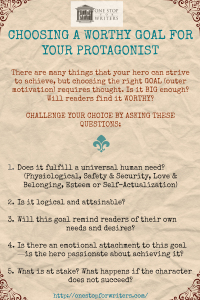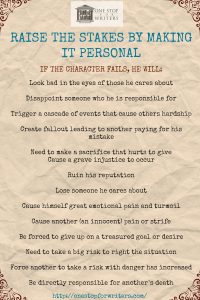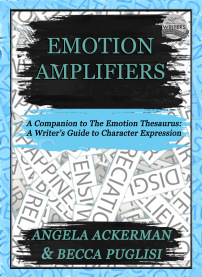Angela Ackerman's Blog: Writers Helping Writers, page 141
November 16, 2015
The Fatal Flaw of Underwriting
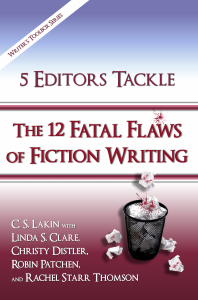 Hi everyone–I hope you had a terrific weekend and are in the mood to learn. Today I’m handing over the blog keys to Rachel Starr Thomson, one of the editors who have jointly written 5 Editors Tackle the 12 Fatal Flaws of Fiction Writing. I’m excited about this venture of Rachel’s as the book features more than sixty detailed Before and After examples of flawed and corrected passages to help authors learn to spot flaws in their writing. Seeing real examples is a great way to elevate your writing.
Hi everyone–I hope you had a terrific weekend and are in the mood to learn. Today I’m handing over the blog keys to Rachel Starr Thomson, one of the editors who have jointly written 5 Editors Tackle the 12 Fatal Flaws of Fiction Writing. I’m excited about this venture of Rachel’s as the book features more than sixty detailed Before and After examples of flawed and corrected passages to help authors learn to spot flaws in their writing. Seeing real examples is a great way to elevate your writing.
The Fatal Flaw of Underwriting
Fundamentally, when we write a story, we want to connect with readers’ emotions. Engage emotion. Elicit it. Give readers a story they don’t just learn but one they feel and will never forget.
Yet emotion is one of the story elements most commonly underwritten—and underwriting in general tends to harm emotional connection the most.
Underwriting is just what it sounds like: it’s the failure to put things on the page that need to be there. When somebody picks up a gun and fires it off, and we didn’t know there was a gun on stage, that’s underwriting. When someone makes a decision completely out of the blue, leaving us not so much surprised as confused, that’s underwriting. When a story just plain doesn’t make sense, it’s probably underwritten.
And when no matter how hard you try, you just can’t give a damn about the characters? Most likely underwriting is at fault.
Why We Underwrite
The dirty little secret, though? Underwriting is sometimes (often) a direct result of following editorial advice like “show, don’t tell,” and “make sure your scenes are active and full of conflict” and “don’t info dump or fill your scenes with backstory.”
As an editor who also writes stuff (a lot of stuff), allow me to eat humble pie and tell you that sometimes we push you to strip so much out of your story that it ends up gasping for breath, struggling to hang on to a shred of character or conflict that anyone cares about.
I’ve been there. I once misinterpreted “show don’t tell” so horrendously that I thought it meant everything had to be conveyed through action and dialogue alone, and I was never allowed to include thoughts or backstory. Talk about gutting a book!
Connecting
Underwriting hurts emotional connection so badly because it turns everything 2D. We lose contact with really essential parts of our stories, settings, and characters when we fail to include what needs to be there.
In particular, these three often-underwritten areas can make or break connection:
Process. When your character goes from decision point A (“I will not go to the ball”) to decision point B (“I will go to the ball”), and we didn’t see any of the decision process, it’s impossible to feel invested in the question. The Rule of Three is helpful here: in a decision of midlevel importance (meaning it’s more important than “I think I’ll brush my teeth” and less important than “I think I’ll marry the hero after all”), show three stages of the decision-making progress.
I will not go to the ball.
But then I just learned my best friend is going.
If my best friend goes, she will exceed my popularity.
If she exceeds my popularity, I will lose the interest of the prince.
I will go to the ball after all.
Reaction. In my clients’ manuscripts, it’s amazing how often something will happen that ought to get a reaction from the POV character … and it doesn’t. I mean, somebody’s mother might have just died, and we get crickets. When you’re in POV you always always always have to react. Even if you don’t react, it has to be because you’re being so darn deliberate about not reacting. If the temperature drops, shiver. If someone dies, cry. If someone says something provocative, have an opinion about it.
Many times, I’ve had a client return a manuscript after revision, and simply by adding reaction—usually in the form of a thought, shown through deep POV—they had absolutely transformed the story. A character who responds to things is alive, and through that character, the story can be experienced at far greater depth.
The Thoughts Behind Emotion. This is a biggie, and it’s where “show don’t tell” can be so incredibly damaging when misunderstood. We know not to write “She was angry.” So instead, many writers revert to writing “body emotions”: “She ground her teeth.” “She turned red.” This makes for a lot of odd and sometimes unclear images, but it doesn’t connect us to the character’s emotion at all. We see her feeling something; we don’t feel it. The best way to convey emotion, it turns out, is to write thoughts. We feel in response to things we’re thinking. So do our characters. If you can show what they are thinking, nine times out of ten you can make an emotional connection with your readers.
Words are the stuff of our worlds. Without words to translate into vivid images, actions, thought processes, emotions, settings, and more, none of those things can exist. So underwriting is actually as great a danger to a novelist as overwriting—perhaps even a greater one.
Thankfully, underwriting not irreparable. In fact, when we go and fill in the gaps, we might just discover the missing heart of our own stories.
 Rachel Starr Thomson is the author of eighteen novels. As an editor and writing coach, she has helped writers achieve their best work for over a decade—so she’s thrilled to contribute to The Writer’s Toolbox series, which gives fiction writers everything they need to know to create compelling, solid stories, with 5 Editors Tackle the 12 Fatal Flaws of Fiction Writing.
Rachel Starr Thomson is the author of eighteen novels. As an editor and writing coach, she has helped writers achieve their best work for over a decade—so she’s thrilled to contribute to The Writer’s Toolbox series, which gives fiction writers everything they need to know to create compelling, solid stories, with 5 Editors Tackle the 12 Fatal Flaws of Fiction Writing.
You can check out all Rachel’s books at her website.
Which of these three areas of underwriting do you struggle with? Let us know in the comments!
The post The Fatal Flaw of Underwriting appeared first on WRITERS HELPING WRITERS™.
November 12, 2015
On Writing Badly and Redefining Failure
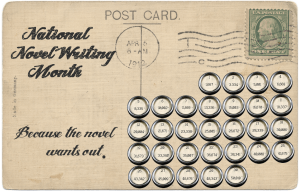
Credit: Monda at Creative Commons
I want to start by saying how proud I am of all of you who are attempting NaNoWriMo. I’ve done NaNo before, and I know how hard it is to plan and write an entire story in one month. I remember the struggle, and I still remember the lessons that I learned during the process. Because I know that many of you might be hitting the wall, I’d like to share some inspiration that might help you soldier through.
The thing that frustrated me the most when I started drafting was how blah the writing was. It was hard enough to get the words down, and once I did, I was completely underwhelmed by them. Then I stumbled across this quote by Shannon Hale that’s been making the rounds:
I’m writing a first draft and reminding myself that I’m simply shoveling sand into a box so that later I can build castles.
Yes. Yes! By all that is holy, YES! This is what we do. We shovel words onto paper, as fast as we can, knowing—even expecting—them to be fairly crappy. Don’t worry about correct word choice, proper grammar, or flair. Just get the words down. That’s what you’re aiming for this month.
And that ties in to my second mantra, stolen from Dean Wesley Smith:
Dare to be bad
I’m a little weird in that drafting is the most difficult part of the process for me. Every day when I sit down to write, it takes forever to get going. For me—and for a lot of writers, I’ve learned—it all comes down to fear. Fear of starting in the wrong place, of wasting time, of going through all this effort and the story not being any good—all of this stymies the writing. It wasn’t until I read Dean’s advice that I freed myself up to write badly. I realized that the only writers who do get it right the first time around are the ones who’ve been doing it for years and have written roughly a gajillion words. I’m not there yet. But I will be, if I keep writing. And so will you. So when you’re struggling through that first draft and you’re afraid that it totally sucks, don’t worry. Dare to be bad, and just finish the story. You’ll have plenty of time to pretty it up later. That’s what the revision process is for.
And that leads to a favorite quote—this one from Kristen Lamb—that we all need to remember from time to time:
Redefine Failure
When I started my NaNo, I aimed for the standard goal of 50,000 words. It became clear very quickly that I wasn’t going to make it. Wasn’t even going to come close. I had to revise my goal, and I ended up with 30,000 words— barely a third of my novel. At first I was disappointed that I had achieved so little. But then I realized, No. I had planned and outlined an entire novel. Wrote the first third of it with a preschooler underfoot. Wrote 30,000 words that I wouldn’t have had under my belt if I hadn’t tried. Mastered some new techniques that are getting me closer to being able to write those solid first drafts. I had to redefine my notions of success and failure to appreciate all that I’d accomplished in just thirty days.
And that’s my hope for each of you: Get the words down on paper. Don’t worry about the quality. And realize that what you’re doing is A-MAZING. This month is about more than just finishing a book. It’s also about the writing, whether that’s 5000 words or 50,000. With every word you write, you learn. As you learn, you improve. And as you improve, the process gets easier.
You’re doing great! Keep up the good work!
The post On Writing Badly and Redefining Failure appeared first on WRITERS HELPING WRITERS™.
November 9, 2015
NaNoWriMo Triage Center: Helping You Get To 50K
There you are, happily pounding out words, the click and rattle of the keyboard creating a musical symphony in your writing space. Maybe you’re humming along, caught up in the frenzy of creation that oozes out every pore. When the scene finishes, you stop, roll your shoulders, sip at coffee gone cold, but who cares son, because cold coffee means VICTORY in a writer’s world.
A neck crack and a handful of nourishing Skittles later, you poise your fingers over the keyboard, ready to begin again.
Only…nothing comes.

The NaNoWriMo Boogeyman
You stare at the blinking cursor, then your fingers. Why aren’t they moving, directing fictional lives, creating worlds?
Come on, you urge. Get to work. They remain still, splayed out in knobby hooks of rigor mortis.
A familiar feeling curls through your belly, sliding around in a slow dance before fanning through your chest and netting it tight. It is an emotion you dare not name. But deep down, you know. It’s happening, the thing you prayed would not come to pass this November: a visit from the NaNoWriMo boogeyman, The Big Blank.
DON’T PANIC. I REPEAT, DON’T PANIC.
The big blank, the block, the curtain that draws across your story vision. It happens, and it can happen to you. Remain calm. Breathe. This is the triage center, a place for you to come when your writing stalls and you need some help to get moving again.
Choose your blank & click the link. Get the help you need and then grab your keyboard and write.
CHARACTER BLANKS
Introduce a Secret
Let’s face it, sometimes our characters seem a bit blah on the page. It might be your hero, the sidekick or even the villain. And while I’d normally suggest you dig deeper into your character to develop them more, mid-novel during NaNoWriMo, a person can’t always re-plan a character. So, try giving your character a secret. Not something lame-ass, but a secret with depth, birthing from a place of Guilt, Shame, Exploitation or Necessity.
Give Him or Her An Unusual Skill or Talent
To make your character stand out on the page, focus on how to make him unique. Is there a Talent or Skill that adds zing and factors into the plot? Here’s a list of ideas to get you started.
Sometimes we need to work on the connection between a character and a reader, and the area to explore to create empathy is WORTHINESS. Giving him an undeserved misfortune isn’t enough. It is what a character does despite his hardship that pulls readers in.
STORY MIDDLE BLANKS
Focus on Motivation
Ran out of steam, did you? It’s okay, the middle of a story can be a tricky place. You don’t want to wrap things up too quickly, but at the same time, not…much…seems to be…happening. When you get stuck and don’t know where to go next, think MOTIVATION. Your hero should always be motivated to act, making decisions, choices, weighing options. Always know what is motivating your character, and you’ll be able to put one foot in front of the other again.
Have Him Look In a Mirror
If you’re lost in the middle, make haste to the midpoint & mirror moment when your hero looks within, has an emotional epiphany, and that leads to change and purpose.
Seek Out an Expert
James Scott Bell knows all about writing the middle of a novel, so much that he’s written a book about it. A book, I might add, you should own (and all his others).
PLOTTING BLANKS
Throw a Curve Ball
Tension makes the world go round. If your characters are stalling on what to do, it’s time to amp things up and spread some pain. Follow this one-two-three punch of tension and complicate matters, forcing your hero to adapt to succeed. Remember though, when it comes to frustrating your characters, you need to make sure their reactions & ways of dealing with an upset fit the character.
Introduce a Pressure Point
If your plot is chugging like a car running on cheap gas, it might be time to utilize a pressure point. There’s nothing like a temptation, a challenge, or an opportunity for redemption to push the story forward.
Poke His Wounds
Emotional wounds are a big part of the story, so if the plot trail dries up, return to Character Arc and remember your Character is on a path of CHANGE. Understanding why his wound is important to the story will help lay down some plot pieces for you to follow.
CONFLICT BLANKS
If your conflict is flat-lining, it’s time to raise the stakes. No, I’m not talking about throwing more monsters at your hero for him to kill, or a bigger, nastier bomb for him to diffuse. Instead, Friend-o, let’s personalize those stakes. Give your hero a compelling reason to ACT. How we do that is make sure the character sees that if he doesn’t, something even worse will happen, like undeserved consequences falling in the lap of someone else.
Cross a Moral Line
If your tension is about as hardcore as limp celery, it’s time to bring about a belief crisis. Force your hero to do the unthinkable and cross a moral line for the “greater good.” When the lines between right and wrong grow fuzzy, everything gets complicated in a hurry, which is terrific for juicing up your story.
Friction & Fireworks
You love your cast of characters, I get it. Pass around the flowers, have everyone hold hands and let them get the job done TOGETHER. Very sweet. The problem is, when everyone is playing nicey-nice, the story gets boring fast. Add a healthy dose of tension by creating some clashing personalities who will create story friction.
Nothing adds tension and conflict like a big ol’ stupid mistake. Screw ups are a story’s bread and butter! So let’s get your hero off his game by amplifying his emotions, piling on the stress or pain, or even distracting him with primal pull of attraction, hunger or thirst. You pick the amplifier, apply it, and watch the emotional overreactions lead to bad judgement and rashness that creates delicious story fallout. (Oh yeah–this ebook is free, by the way.)
BRAINSTORMING BLANKS
Sometimes the creative well empties and our brain turns to static. But it’s NaNoWriMo season, and nobody’s got time for that. Pull out the big guns and get going.
The Writers Helping Writers Descriptive Thesaurus Collections
 Two words: Description Nirvana. When you’re struggling with finding the right sensory detail for settings, check the Setting Thesaurus. Looking to add some symbolism and motif depth, describe your characters’ physical features, their emotions, unique personality traits or a host of other things? We’ve got you covered, all accessible right here at WHW.
Two words: Description Nirvana. When you’re struggling with finding the right sensory detail for settings, check the Setting Thesaurus. Looking to add some symbolism and motif depth, describe your characters’ physical features, their emotions, unique personality traits or a host of other things? We’ve got you covered, all accessible right here at WHW.
One Stop For Writers: A Library Like No Other
 Like the WHW sample thesaurus collections, do you? Well then you will love One Stop, where all the grown up versions of our thesaurus collections live (including the bestselling book versions of The Emotion Thesaurus, Positive Trait Thesaurus, Negative Trait Thesaurus and the yet-to-be-released Setting Thesaurus books [Spring 2016].) Hundreds of new entries & expanded content, tutorials, generators and one-of-a-kind worksheets make this a powerhouse library for writers. It’s all searchable with a click, making NaNoing that much easier. Registration is free, so you can test drive the site.
Like the WHW sample thesaurus collections, do you? Well then you will love One Stop, where all the grown up versions of our thesaurus collections live (including the bestselling book versions of The Emotion Thesaurus, Positive Trait Thesaurus, Negative Trait Thesaurus and the yet-to-be-released Setting Thesaurus books [Spring 2016].) Hundreds of new entries & expanded content, tutorials, generators and one-of-a-kind worksheets make this a powerhouse library for writers. It’s all searchable with a click, making NaNoing that much easier. Registration is free, so you can test drive the site.
NOW KEEP WRITING
If all else fails and you can’t seem to get over the Big Blank, go around him. Put in a sentence or two as a placeholder, and then move forward in the story to a point where you feel on solid ground again. Later, you can come back and fill in the blanks. Chances are if your brain has time to think about the problem without feeling pressured to perform, you’ll sort it out on your own and be able to add in the missing scenes.
Happy writing, Fearless NaNo Warrior! See you at 50K!
Image: Currens @ Pixabay
The post NaNoWriMo Triage Center: Helping You Get To 50K appeared first on WRITERS HELPING WRITERS™.
November 7, 2015
Emotional Wound Entry: A Home Invasion
When you’re writing a character, it’s important to know why she is the way she is. Knowing her backstory is important to achieving this end, and one of the most impactful pieces of a character’s backstory is her emotional wound. This negative experience from the past is so intense that a character will go to great lengths to avoid experiencing that kind of pain and negative emotion again. As a result, certain behaviors, beliefs, and character traits will emerge.
 Characters, like real people, are unique, and will respond to wounding events differently. The vast array of possible emotional wounds combined with each character’s personality gives you many options in terms of how your character will turn out. With the right amount of exploration, you should be able to come up with a character whose past appropriately affects her present, resulting in a realistic character that will ring true with readers. Understanding what wounds a protagonist bears will also help you plot out her arc, creating a compelling journey of change that will satisfy readers.
Characters, like real people, are unique, and will respond to wounding events differently. The vast array of possible emotional wounds combined with each character’s personality gives you many options in terms of how your character will turn out. With the right amount of exploration, you should be able to come up with a character whose past appropriately affects her present, resulting in a realistic character that will ring true with readers. Understanding what wounds a protagonist bears will also help you plot out her arc, creating a compelling journey of change that will satisfy readers.
NOTE: We realize that sometimes a wound we profile may have personal meaning, stirring up the past for some of our readers. It is not our intent to create emotional turmoil. Please know that we research each wounding topic carefully to treat it with the utmost respect.
A HOME INVASION
Examples: having one’s house broken into while one is home, either alone or with one’s family present, and then forced through the ordeal of being robbed, victimized, assaulted (physically, mentally or sexually), kidnapped or a enduring a combination of these violent elements.
Basic Needs Often Compromised By This Wound: physiological needs, safety and security, love and belonging, esteem and recognition, self-actualization
False Beliefs That May Be Embraced As a Result of This Wound:
strangers should be feared
everyone I don’t know well could be a potential threat
if I’m not safe in my own home, I’m not safe anywhere
showing sympathy, empathy or kindness are signs I’m weak
I can’t keep my loved ones safe
I am to blame for what happened (for not having proper home security, for not locking the door, for not being strong enough, for not acting differently in the situation, etc.)
the police are inefficient, inept, can’t protect me, etc.
the world is not a safe place
I have no real control over my life or what happens
Positive Attributes That May Result: alert, analytical, cautious, independent, introverted, mature, meticulous, observant, perceptive, private, protective, responsible, sentimental, wise
Negative Traits That May Result: abrasive, apathetic, cowardly, defensive, compulsive, evasive, humorless, inflexible, insecure, irrational, materialistic, nervous, obsessive, paranoid, pessimistic, prejudiced, suspicious, timid, uncommunicative, withdrawn
Resulting Fears:
fear of strangers
fear of visitors
fear of being alone
fear of violence
fear of a particular person “type” or “ethnicity” tied with one’s ordeal
fear of criminals
fear of weapons associated with the ordeal
fear of intimacy and sex (if one was sexually assaulted)
fear of particular elements associated with the ordeal (enclosed spaces if one was in a closet hiding, for example)
Possible Habits That May Emerge:
obsessive about home safety, checking locks, installing floodlights, getting a dog, getting a security system
becoming hyper sensitive in one’s surroundings (focusing on noises one would simply dismiss before, tracking movement, etc.)
Becoming withdrawn or secretive
struggling when one is alone, even suffering panic attacks and paranoia
difficulty sleeping/insomnia, waking with a racing heartbeat
feeling uncomfortable around weapons or even kitchen implements, if they remind one of the attack
buying a weapon for home protection or joining a self-protection class
creating a safe room within one’s home, fortified with locks and home protection
difficulty concentrating, being non-responsive in conversations
jumping at loud noises
anxiety flare ups (racing heartbeat, dizziness, trouble breathing) at certain triggers tied to the trauma (the smell of beer breath, breaking glass, the sight of blood, etc.)
feeling followed or watched
feeling unsafe in one’s home but being too fearful to leave it
reliving what happened over and over
having a difficult time enjoying the little things, finding joy, smiling, laughing, etc.
needing to know where one’s children are at all time
TIP: If you need help understanding the impact of these factors, please read our introductory post on the Emotional Wound Thesaurus. For our current list of Emotional Wound Entries, go here.
For other Descriptive Thesaurus Collections, go here.
Image: Republica @ Pixabay
The post Emotional Wound Entry: A Home Invasion appeared first on WRITERS HELPING WRITERS™.
November 5, 2015
Critiques 4 U
Happy November, everyone! As a recent transplant from Florida to New York, I am TOTALLY LOVING THE FALL—which, you know, never actually happens in Florida. It just shifts from ridiculously hot to uncomfortably warm. But here…The leaves changed color, my kids raked them up and jumped into piles, and for the first time ever, we didn’t sweat on Halloween. And now that our house is done and we’ve moved in, I can enjoy this wonderful view while critiquing your first pages!
But don’t worry. I won’t get distracted, because while I adore fall, I also love our monthly Critiques 4 U contest. So…if you’re working on a first page and would like some objective feedback, please leave a comment that includes:
1) your email address. Some of you have expressed concern about making your email address public; if you’re sure that the email address associated with your WordPress account is correct, you don’t have to include it here. But if you do win and I’m unable to contact you through that email address, I’ll have to choose an alternate winner.
2) your story’s genre (no erotica, please)
ONLY ENTRIES THAT FOLLOW THESE INSTRUCTIONS WILL BE CONSIDERED
Three commenters’ names will be randomly drawn and posted tomorrow. If you win, you can email me your first page and I’ll offer my feedback. Best of luck!
The post Critiques 4 U appeared first on WRITERS HELPING WRITERS™.
November 2, 2015
Building a Great First Chapter with NYT Bestselling Author Beth Revis
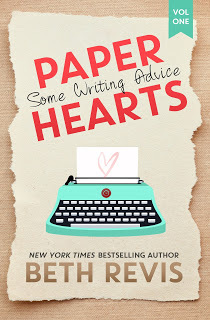 Hi everyone! Today we’re handing the blog over to NYT bestselling author Beth Revis (did you read her Across The Universe trilogy? I did and loved it!). Beth has taken all her hard-won writing knowledge and packed into a new guide book for writers called Paper Hearts, the first in a series on Writing, Publishing and Marketing.
Hi everyone! Today we’re handing the blog over to NYT bestselling author Beth Revis (did you read her Across The Universe trilogy? I did and loved it!). Beth has taken all her hard-won writing knowledge and packed into a new guide book for writers called Paper Hearts, the first in a series on Writing, Publishing and Marketing.
Beth is sharing a bit of her book with us, looking specifically at what ingredients go into a strong first chapter, so please read on. Plus, there’s a giveaway at the bottom of this post.
The two most important chapters of a novel for most readers are the first chapter and the last chapter. The first chapter hooks the reader; the last chapter hooks the reader for your next book.
When writing your first chapter, there are a few specific things you probably need:
EMPATHETIC CHARACTERS
Empathy doesn’t mean that you feel bad or good for a character; it means that you understand what the character is feeling and why. In Across the Universe, my main character, Amy, watches her parents undergo a painful medical procedure in the first chapter. This is something that anyone can empathize with – we know how we would feel if our own parents or loved ones underwent a painful procedure. This immediately puts us in the picture with the main character. Possibly the most important thing you can do as a writer is create empathetic characters. Think of Katniss and her love for Prim in The Hunger Games – that was chapter 1. Think of Bella meeting Edward in Twilight or Harry Potter becoming an orphan. These are things with which we can empathize.
SYMPATHETIC SITUATION
While your characters need to be empathetic, it’s good to start the story with a sympathetic situation. You have a character who you can almost visualize as yourself – you understand where they’re coming from and who and why they are. Now put them in a situation we wouldn’t want to be in. Make us feel bad that these characters we identify with are in a bad situation.
While you make the character sympathetic with the situation she’s in, beware of going too far, or having her react in an unsympathetic way. We empathize with Katniss because she loves her sister, we sympathize with her because she’s in a horrible situation with the presence of the Games, and we love her because of her survival attitude. Had she been whiney or mean, cruel or abusive, all that empathy and sympathy would disappear. Katniss would have every right to whine and wallow in self pity in this situation—most of us would do just that—but because she doesn’t, we respect her and grow to love her character.
IT IS WHAT IT SAYS IT IS ON THE COVER
You should also definitely give some hint of what the book is. You’re giving readers a taste of the whole book in the first chapter. If it’s a sci fi novel, you need a spaceship or cryogenic freezing in chapter one. If it’s a survival story like The Hunger Games, have Katniss shoot her bow. Harry mentions magic. Elizabeth Bennet’s mother in Pride and Prejudice mentions marriage. Whatever your story is overall, there must be a hint of it here, in the first pages. I should know what genre you’re writing not from your cover or your back jacket description, but from your first chapter.
IMMEDIATE CONFLICT TO FORESHADOW FUTURE CONFLICT
Writers are often told to start their novels with a bang – but that can often lead to overly dramatic (and melodramatic) first chapters. Instead, try to mirror a larger conflict within the first chapter with something smaller. In my novel, Amy watching her parents being cryogenically frozen mirrors how later, when she wakes up, she has to make tough decisions without them. For The Hunger Games, Katniss’s hunt in the first chapter mirrors the battle for survival that the whole book revolves around. For Lucy Pevensie in The Chronicles of Narnia it’s the way her brother Edmund treats her. In the first Harry Potter book, Harry’s problems with Dudley echo his problems with Draco later.
Your action needs to be buildable—it should constantly be escalating—so keep what’s happening in Chapter 1 both relatable and prescient.
Interested in finding out more about the Paper Hearts Series?
Your enemy is the blank page. When it comes to writing, there’s no wrong way to get words on paper. But it’s not always easy to make the ink flow. Paper Hearts: Some Writing Advice won’t make writing any simpler, but it may help spark your imagination and get your hands back on the keyboard.
Practical Advice Meets Real Experience
With information that takes you from common mistakes in grammar to detailed charts on story structure, Paper Hearts describes:
How to Develop Character, Plot, and World
What Common Advice You Should Ignore
What Advice Actually Helps
How to Develop a Novel
The Basics of Grammar, Style, and Tone
Four Practical Methods of Charting Story Structure
How to Get Critiques and Revise Your Novel
How to Deal with Failure
And much more!
Preorder it now from: Independent Bookstore ~ Amazon ~ BN ~ Kobo ~ Smashwords
 Beth Revis is the New York Times bestselling author of the Across the Universe trilogy, as well as The Body Electric, Paper Hearts, and the forthcoming A World Without You. She lives in the Appalachian mountains with her boys: one husband, one son, and two very large dogs.
Beth Revis is the New York Times bestselling author of the Across the Universe trilogy, as well as The Body Electric, Paper Hearts, and the forthcoming A World Without You. She lives in the Appalachian mountains with her boys: one husband, one son, and two very large dogs.
You can find out more on Facebook, Twitter, or online. If you never want to miss a thing and also get exclusive insider opportunities, sign up for her newsletter here. Also feel free to add Paper Hearts to your Goodreads list, and if you like, enter Beth’s Rafflecopter giveaway for a signed copy, some swag and other extras!
What gives you the biggest trouble when it comes to the first chapter? Let Beth know in the comments!
The post Building a Great First Chapter with NYT Bestselling Author Beth Revis appeared first on WRITERS HELPING WRITERS™.
October 31, 2015
Emotional Wounds Entry: Being the Victim of a Vicious Rumor
When you’re writing a character, it’s important to know why she is the way she is. Knowing her backstory is important to achieving this end, and one of the most impactful pieces of a character’s backstory is her emotional wound. This negative experience from the past is so intense that a character will go to great lengths to avoid experiencing that kind of pain and negative emotion again. As a result, certain behaviors, beliefs, and character traits will emerge.
Characters, like real people, are unique, and will respond to wounding events differently. The vast array of possible emotional wounds combined with each character’s personality gives you many options in terms of how your character will turn out. With the right amount of exploration, you should be able to come up with a character whose past appropriately affects her present, resulting in a realistic character that will ring true with readers. Understanding what wounds a protagonist bears will also help you plot out her arc, creating a compelling journey of change that will satisfy readers.
NOTE: We realize that sometimes a wound we profile may have personal meaning, stirring up the past for some of our readers. It is not our intent to create emotional turmoil. Please know that we research each wounding topic carefully to treat it with the utmost respect.

Credit: S Packwood @ Creative Commons
Examples: Rumors can be incredibly destructive and hurtful, whether they’re started by a friend or family member, co-worker or employer, a rival, an enemy, or a complete stranger. In today’s interconnected world, rumors can have especially far-reaching and long-lasting effects.
Basic Needs Often Compromised By This Wound: love and belonging, esteem and recognition, self-actualization
False Beliefs That May Be Embraced As a Result of This Wound:
No one will ever believe me.
I’m never going to be able to overcome this.
I won’t be able to achieve my hopes and dreams with this hanging over my head.
If people are going to believe this about me anyway, I might as well embrace it.
Why did they target me? There must be something wrong with me.
Getting back at them will even the score.
Why would they make that up? Maybe it’s true on some level.
Positive Attributes That May Result: independent, just, kind, patient, persuasive, private, proper, sensible
Negative Traits That May Result: addictive, callous, catty, confrontational, cynical, defensive, evasive, gossipy, hostile, humorless, inhibited, insecure, martyr, melodramatic, obsessive, oversensitive, paranoid, pessimistic, reckless, resentful, self-destructive, self-indulgent, subservient, temperamental, timid, uncommunicative, vindictive, volatile, withdrawn
Resulting Fears:
Fear of betrayal
Fear of not being believed
Fear of revealing truths about oneself
Fear of being limited by the rumors
Possible Habits That May Emerge:
Withdrawing from others
Avoiding those places where people have heard the rumor
Seeing vengeance against those who started the rumor
Lashing out at the rumormongers
Reluctance to share one’s secrets with others
Believing the lie
If the rumors persist, one may begin to embrace the lie and live as it if was true.
Cutting off recently-formed relationships; clinging to the few people one knows can be trusted
Granting more power to the rumor than it has (believing that everyone one meets has heard the rumor, that it has spread farther than it really has, etc.)
Making it a life’s goal to prove the rumor wrong
Throwing oneself into other hobbies, interests, or areas of skill in order to prove oneself
Changing schools, switching jobs, or moving in an effort to start over
TIP: If you need help understanding the impact of these factors, please read our introductory post on the Emotional Wound Thesaurus. For our current list of Emotional Wound Entries, go here.
For other Descriptive Thesaurus Collections, go here.
The post Emotional Wounds Entry: Being the Victim of a Vicious Rumor appeared first on WRITERS HELPING WRITERS™.
October 27, 2015
How Your Hero’s Past Pain Will Determine His Character Flaws
Authentic characters are usually modeled after real people. I don’t mean pulling traits and quirks from those we know (say, taking Aunt Judy’s laughter and blending it with the overly-smiley bus driver who takes us to work on Tuesdays and Thursdays). Rather, I’m talking about mirroring the human experience in the fictional world, giving readers a character who has desires they can relate to, and who struggles, fails or succeeds all in turn.
 Human experience is also about the push for self-discovery, finding meaning, and achieving worthy goals. Just like real people do, our characters should seek to improve themselves in some way—at work, in personal relationships, spiritually, or through self-growth.
Human experience is also about the push for self-discovery, finding meaning, and achieving worthy goals. Just like real people do, our characters should seek to improve themselves in some way—at work, in personal relationships, spiritually, or through self-growth.
In fiction, the road to what one desires is never easy. Authors want to create a window into this internal life struggle that we all know so well. To do so, we write characters who have flaws–negative qualities that surface at the worst of times, sabotaging their efforts, blocking them from gaining what they want both on a conscious and subconscious level. It’s ironic, really; who they are and what they want are often at odds, making it difficult for them to achieve success.
As you can imagine, choosing the right flaws for a character is really important as they will directly affect character arc and how the story plays out for readers. So let’s look at why flaws become part of who someone is, and where they come from.
Digging Up Backstory: Negative Influencers & Experiences
In real life, who we are now is a direct result of our own past, and so in fiction, we need to look at who our story’s cast were before they stepped onto the doorstep of our novel. Many factors play a part in determining who our characters become, including the way they were raised, their role models, environment, and genetics. And if the character’s world is anything like ours, it’s filled with flawed people because life isn’t a perfect, well-balanced nirvana. And when it comes to the negative experiences or influences, each impart a lesson, and usually not a healthy one.
For example, specific events and long-term exposure to unhealthy ideas, behavioral patterns, and relationships can hamstring a character. An ignorant character, for instance, may be ignorant due to years of poor teaching, or from being sheltered in a way that limited his ability to connect or get along with others. This history of not being taught the whole truth creates a deficiency in his personality that undermines his ability to reach his full potential. An evasive character, on the other hand, may be this way as a result of seeing someone he cared about be taken advantage of by others because they spoke the truth, or they were overly trusting when they should have been on their guard.
 While these past situations are important, the most crippling factor—the one that authors should always strive to unearth from their characters’ pasts—is emotional trauma. Old hurts can have a huge impact on our characters, influencing their current behavior. Emotionally painful events like these are called wounds and are profoundly powerful. This defining emotional experience from a character’s past is so debilitating that he’ll do anything to avoid suffering the same kind of pain again. It colors how he views the world and alters what he believes about himself and others. This traumatic experience instills a deep fear that the same hurt will happen again if the character doesn’t protect himself against it.
While these past situations are important, the most crippling factor—the one that authors should always strive to unearth from their characters’ pasts—is emotional trauma. Old hurts can have a huge impact on our characters, influencing their current behavior. Emotionally painful events like these are called wounds and are profoundly powerful. This defining emotional experience from a character’s past is so debilitating that he’ll do anything to avoid suffering the same kind of pain again. It colors how he views the world and alters what he believes about himself and others. This traumatic experience instills a deep fear that the same hurt will happen again if the character doesn’t protect himself against it.
Physical defects with a lasting psychological effect, such as a crippling illness or disfigurement, can have the same result. In both cases, the mistaken belief that the character must harden himself in order to be emotionally safe is what allows negative traits to emerge.
The Character’s Wound
Wounds are often kept secret from others because embedded within them is the lie—an untruth that the character believes about himself (or a skewed belief about the world). He may think that he deserved what happened to him, that he’s unworthy of love or affection or happiness, etc. Self-blame and feelings of shame are usually deeply embedded within the lie and it generates fears that compel him to change his behavior in order to keep from being hurt again.
For example, if a man believes he is unworthy of love (the lie) because he was unable to stop his fiancee from being shot during a robbery (the wound), he may adopt attitudes, habits, and negative traits that make him undesirable to other women. If he does grow close to someone, he might sabotage the relationship before it can become too serious. He may also avoid situations in which he is responsible for others, believing that he will only fail them in the end.
To use a less dramatic scenario, consider a daughter growing up with a father whose work was more important than his family (the wound). This girl may become a workaholic adult due to her belief that the only way to gain the attention and acceptance of others is through career achievement (the lie). Although she wants a family of her own, she may sacrifice that desire so she can dedicate herself to work. Her health declines, friends become marginalized, and her life revolves only around activities that promote her career, leaving her successful at work but unfulfilled in her heart.
The lie plaguing your character should center on one of five basic human needs:
1) To secure one’s biological and physiological needs
RELATED LIE: I’m not capable of providing for myself or anyone else
2) To keep oneself and one’s family safe
RELATED LIE: I don’t deserve to feel safe
3) To feel connected to and loved by others
RELATED LIE: I am not worthy of love or affection
4) To gain esteem, both from others and from oneself
RELATED LIE: I can’t do anything right
5) To realize one’s full potential
RELATED LIE: I’ll never be a good ____ (parent, employee, friend, etc.)
Many secondary flaws result organically from one’s upbringing or environment rather than birthing violently from a traumatic wound, but a character’s major flaw should always be traced back to a defining hurtful experience. This flaw will compromise his path to achieving his dreams and prevent him from reaching his full potential. It is this weakness that the character will eventually have to overcome by revisiting the past and coming to terms with his old wound.
Wounds are powerful, both in real life and in fiction. Taking the time to probe you’re character’s past to find their emotional pain will help you better understand what motivates them and how they will behave when crises arise and choices must be made. One tool to help with understanding a character’s past, motivation, emotional sensitivities and more is the Reverse Backstory Tool. Full guidelines are in the Negative Trait Thesaurus, and a downloadable chart can be found HERE. Also, the Emotional Wound Thesaurus is a treasure trove of ideas for wounds, and serve as great examples for how much a wound will alter you’re character’s behavior.
Does your hero have a wound? What fear does it mask? What lie does the character believe about himself as a result? Let me know in the comments!
 Before you go…
Before you go…Today is the last day to get your hands on free One Stop For Writers passes. Imagine having One Stop at your side during NaNoWrimo…you would be unstoppable, a demon with a keyboard!
So why not try to win 10 passes for your NaNoWriMo Group, and be the Superhero of November? 100 passes are up for grabs and all the details are right here…good luck!
Image 1: jill 111 @ Pixabay
Image 2: wocandapix @ Pixabay
The post How Your Hero’s Past Pain Will Determine His Character Flaws appeared first on WRITERS HELPING WRITERS™.
October 24, 2015
Emotional Wound Entry: A Speech Impediment
When you’re writing a character, it’s important to know why she is the way she is. Knowing her backstory is important to achieving this end, and one of the most impactful pieces of a character’s backstory is her emotional wound. This negative experience from the past is so intense that a character will go to great lengths to avoid experiencing that kind of pain and negative emotion again. As a result, certain behaviors, beliefs, and character traits will emerge.
 Characters, like real people, are unique, and will respond to wounding events differently. The vast array of possible emotional wounds combined with each character’s personality gives you many options in terms of how your character will turn out. With the right amount of exploration, you should be able to come up with a character whose past appropriately affects her present, resulting in a realistic character that will ring true with readers. Understanding what wounds a protagonist bears will also help you plot out her arc, creating a compelling journey of change that will satisfy readers.
Characters, like real people, are unique, and will respond to wounding events differently. The vast array of possible emotional wounds combined with each character’s personality gives you many options in terms of how your character will turn out. With the right amount of exploration, you should be able to come up with a character whose past appropriately affects her present, resulting in a realistic character that will ring true with readers. Understanding what wounds a protagonist bears will also help you plot out her arc, creating a compelling journey of change that will satisfy readers.
NOTE: We realize that sometimes a wound we profile may have personal meaning, stirring up the past for some of our readers. It is not our intent to create emotional turmoil. Please know that we research each wounding topic carefully to treat it with the utmost respect.
SPEECH IMPEDIMENT
Examples:
Apraxia (sounding out words incorrectly due to brain damage caused by an illness or stroke)
Stuttering
Developmental dyspraxia (childhood speech difficulties)
Muteness (being unable to speak)
Speech sound disorders and lisps
Speech issues due to damage done to the larynx or a condition such as a cleft palate
Injuries to the mouth or throat
Basic Needs Often Compromised By This Wound: safety and security, love and belonging, esteem and recognition
False Beliefs That May Be Embraced As a Result of This Wound:
People hate listening to me speak and can’t wait to get away from me
I have nothing worth saying anyway
I can never make a difference because of my speech
It’s better for me to keep quiet
Everyone else speaks just fine, I must be stupid
Even if I have something important to say, no one will listen
It’s better to avoid relationships because they lead to ridicule
No one understands what this is like
I can never be a leader, only a follower
Positive Attributes That May Result: analytical, appreciative, calm, cautious, centered, cooperative, courageous, curious, disciplined, empathetic, focused, generous, gentle, honorable, idealistic, imaginative, independent, inspirational, kind, loyal, merciful, nurturing, observant, pensive, philosophical, private, protective, resourceful, socially aware, tolerant, unselfish
Negative Traits That May Result: Antisocial, Cynical, Defensive, humorless, impatient, impulsive, inhibited, insecure, jealous, judgmental, nervous, oversensitive, rebellious, reckless, resentful, self-destructive, stubborn, subservient, temperamental, timid, uncommunicative, withdrawn
Resulting Fears:
fear of public ridicule
fear of being on display or in the spotlight
fear of public speaking
fear of being singled out
fear of intimacy or vulnerability
fear of social events
Possible Habits That May Emerge:
choosing a job that is solitary or has minimal interaction with people
becoming a big reader or movie-watcher
enjoying activities alone (camping, hiking, drawing, gaming, etc.)
choosing to interact with others online where chat, not speech is the medium)
avoiding social functions and family get-togethers
avoiding conversation whenever possible
avoiding eye contact with people to dissuade a conversation from forming
Often engaging in fantasizing or daydreaming
not participating in group sports, clubs or activities
sitting near the exit or at the edge of the room
Making excuses to duck out early when one must attend social or family events
carrying a book, phone or device to allow an escape when one needs it or wants to appear “busy” to others
being emotionally moved by the vocals of a musician that aligns with one’s personal taste in music
TIP: If you need help understanding the impact of these factors, please read our introductory post on the Emotional Wound Thesaurus. For our current list of Emotional Wound Entries, go here.
For other Descriptive Thesaurus Collections, go here.
Image: PeterNguyen11 @pixabay
The post Emotional Wound Entry: A Speech Impediment appeared first on WRITERS HELPING WRITERS™.
October 20, 2015
NaNoWriMo Participants: Win One Stop For Writers Passes For Your Local Group
It’s no secret that Becca and I love NaNoWriMo. We have participated several times (and won, WOOT!) but with the many hats we wear these days, we have not been able to enter the last few years. Instead we usually support our fellow Nanoers by giving away free copies of our books in draws or donations.
 But this year, we have One Stop For Writers!
But this year, we have One Stop For Writers!And boy, if ever there was a writing tool to have by your side during NaNoWriMo, it is One Stop. So, we are giving memberships away in hopes they will give a few folks a leg up as they race to achieve their NaNo 2015 winner’s badge.
Here’s the scoop:
The 10 x 10 Draw:
10 free passes for 10 official NaNoWriMo Regional Groups
Do you belong to an official NaNoWriMo group with a ML (Municipal Liaison?) If so, tell them about our 10 x 10 giveaway because they can enter your group into the draw and possibly win 10 of your members a free month-long pass to One Stop For Writers to use during November!
HOW TO ENTER:
Be a ML (Muncipial Liaison with NaNoWriMo)
Fill out THIS FORM
One entry per ML (but if your group has several MLs, they can each enter, improving your odds!)
Contest is open one week, closing on October 27th at 6:30 EST. All ML entrants welcome if over 18 unless prohibited by law. Official rules here.
Want to be the SUPERHERO of your local NaNoWriMo group?
Talk to your ML and ask them to enter to win 10 free passes. Sha-POW, it’s that easy.
Not doing NaNoWriMo this year? Don’t worry, we have something for you, too!
Today is also Critiques 4 U day, when Becca draws a few lucky winners out of our comment section for a free critique!
So, if you’re working on a first page and would like some objective feedback, leave a comment that includes:
1) your email address. Some of you have expressed concern about making your email address public; if you’re sure that the email address associated with your WordPress account is correct, you don’t have to include it here. But if you do win and I’m unable to contact you through that email address, I’ll have to choose an alternate winner.
2) your story’s genre (no erotica, please)
3) the intended audience
~ONLY ENTRIES THAT FOLLOW THESE INSTRUCTIONS WILL BE CONSIDERED~
Three commenters’ names will be randomly drawn and posted here tomorrow. If you win, you can email Becca your first page and She’ll offer her feedback. Best of luck!
Image: Monicore @ Pixabay
The post NaNoWriMo Participants: Win One Stop For Writers Passes For Your Local Group appeared first on WRITERS HELPING WRITERS™.
Writers Helping Writers
- Angela Ackerman's profile
- 1014 followers


